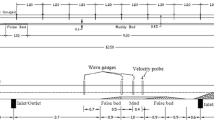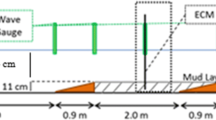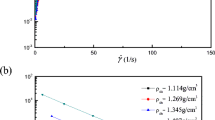Abstract
The generation of internal waves induced by surface wave in the fluid mud environment is examined via laboratory experiment in order to study its importance on surface damping. As wave propagates over soft muddy bottom, both viscous shear stress and interfacial motion contribute to energy dissipation. A fully developed fluid mud layer with a homogeneous concentration distribution is created to investigate the resulting energy dissipation for different wave heights, periods and mud densities. Visualization technique and wave gages were applied to measure interfacial motion and surface damping, respectively. Experimental results suggest that the induced interfacial amplitude depends mainly on the relative water depth, and the mode of internal oscillation was identified. Finally, based on the derived energy equation for two-layer system, we compare the relative importance of shear stress and mud motion.
Graphical Abstract











Similar content being viewed by others
References
Aagaard T, Holm J (1989) Digitization of wave run-up using video records. J Coast Res 5:547–551
Ball FK (1964) Energy transfer between external and internal gravity waves. J Fluid Mech 19:465–478
Bonmarin P, Rochefort R et al (1989) Surface-wave profile measurement by image-analysis. Exp Fluids 7(1):17–24
Canny J (1986) A computational approach to edge detection. IEEE Trans Pattern Anal Mach Intell PAMI-8(6):679–698
Dalrymple RA, Liu PLF (1978) Waves over soft muds: a two layer model. J Phys Oceanogr 8:1121–1131
de Wit PJ (1992) Liquefaction and erosion of mud due to waves and current. Tech. report 10-92. Delft Univ. Tech
Elgar S, Raubenheimer B (2008) Wave dissipation by muddy sea floors. Geophys Res Lett 35:L07611. doi:10.1029/2008GL033245
Gade HG (1958) Effects of a nonrigid, impermeable bottom on plane surface waves. J Mar Res 16:61–82
Hill DF, Foda MA (1998) Subharmonic resonance of oblique interfacial waves by a progressive surface wave. Proc R Soc Lond A 454:1129–1144
Hill DF, Foda MA (1999). Effects of viscosity and elasticity on the nonlinear resonance of internal waves. J Geophys Res 104(C5):10951–10958
Lim JS (1990) Two-dimensional signal and image processing. Englewood Cliffs, NJ, Prentice Hall, pp 478–488
Liu PLF, Chan IC (2007) A note on the effects of a thin visco-elastic mud layer on small amplitude water-wave propagation. Coast Eng 54(3):233–247
Maa JPY, Mehta AJ (1990) Soft mud response to water-waves. J Waterway Port Coast Ocean Eng-Asce 116(5):634–650
MacPherson H (1980) The attenuation of water waves over a non-rigid bed. J Fluid Mech 79:721–742
Otsu N (1978) A threshold selection method from gray level histogram. IEEE Trans Syst Man Cybern 8:62–66
Parau E, Dias F (2001) Interfacial periodic waves of permanent form with free-surface boundary conditions. J Fluid Mech 437:325–336
Parker JR (1997) Algorithms for image processing and computer vision. New York, Wiley, pp. 23–29
Sakakiyama T, Bijker EW (1989) Mass-transport velocity in mud layer due to progressive waves. J Waterway Port Coast Ocean Eng-Asce 115(5):614–633
Scarlatos PD, Mehta AJ (1992) Instability and entrainment mechanisms at the stratified fluiid mud-water interface, nearshore and estuarine cohesive sediment transport. Pac Rim Congr 42:205–223
Torres Freyermuth A, Hsu TJ (2010) On the dynamics of wave-mud interaction: a numerical study. J Geophys Res 115: C07014. doi:10.1029/2009JC005552
Wells JT (1983) Dynamics of coastal fluid muds in low-moderate, and high-tide-range environments. Can J Fish Aqua Sci 40:130–142
Winterwerp JC, van Kesteren WGM (2004) Introduction to the physics of cohesive sediment in the marine environment. Elsevier, Amsterdam
Acknowledgments
The authors would like to thank the National Science Council of the Republic of China, Taiwan, for financially supporting this research under Contract No. NSC. 98-2221-E-006-254–MY3 and NSC-96-2628-E-006-249-MY3.
Author information
Authors and Affiliations
Corresponding author
Rights and permissions
About this article
Cite this article
Hsu, WY., Hwung, HH., Yang, RY. et al. Interfacial wave motion caused by wave-mud interaction. J Vis 15, 215–224 (2012). https://doi.org/10.1007/s12650-012-0131-4
Received:
Accepted:
Published:
Issue Date:
DOI: https://doi.org/10.1007/s12650-012-0131-4




